What is Electric Wire and Why You Need to Choose the Right Type for Your Projects
In the evolving landscape of electrical projects, selecting the appropriate electric wire is crucial for ensuring safety, efficiency, and compliance with industry standards. As technology progresses and new materials become available, it becomes imperative for both professionals and DIY enthusiasts to stay informed about their options. Industry expert Dr. Emily Carter, a leading authority in electrical engineering, emphasizes the importance of this decision by stating, "Choosing the right electric wire not only affects the performance of your project but also ensures the safety of those who will use it."

With an ever-expanding range of electric wire types designed for various applications, understanding their distinct characteristics is essential. From residential installations to complex industrial machinery, the choice of wire impacts factors like conductivity, flexibility, and temperature resistance. As we approach 2025, the demand for specialized electric wire continues to rise, pushing innovators to develop products suited to the specific needs of modern projects. The right selection can make the difference between a successful endeavor and a hazardous situation, highlighting the necessity for informed choices in an increasingly electrified world.
Understanding the Basics of Electric Wire: Types and Specifications
Understanding the different types and specifications of electric wire is crucial for any electrical project. Electric wires are primarily classified into two categories: non-metallic sheathed cable (NM) and underground feeder cable (UF). NM wires are ideal for indoor use, protecting against moisture while UF wires are designed to withstand direct burial and outdoor conditions. According to the National Electrical Code (NEC), selecting the appropriate wire type not only ensures compliance but also enhances safety and efficiency in electrical installations.

When choosing electric wire, pay attention to key specifications such as wire gauge and insulation type. For instance, the American Wire Gauge (AWG) system recommends using a 12-gauge wire for general household circuits, as it can carry up to 20 amps. Insulation types like THHN/THWN are suitable for dry and wet locations, making them versatile for various applications. Reports from the Electrical Safety Foundation International (ESFI) indicate that improper wire selection accounts for a significant percentage of electrical fires, underscoring the importance of making informed choices.
Tips: Always consult a professional or refer to the NEC guidelines when selecting wires for specific projects. Additionally, verify the environmental risks of the installation site to ensure the chosen wire can withstand potential hazards. Regularly check for updates in electrical codes, as they may impact wire selection and safety standards.
Identifying the Right Electric Wire for Different Project Needs
When embarking on any electrical project, identifying the right electric wire is crucial to ensuring safety and efficiency. Different projects require specific types of wires based on their intended use, voltage, and environmental conditions. For instance, for residential wiring, you might opt for NM (non-metallic) cables, which are suitable for inside walls and dry locations. Conversely, for outdoor installations, you may need UF (underground feeder) cables designed to withstand moisture and soil conditions.
Additionally, understanding the gauge of the wire is essential. Thicker wires, measured in lower gauge numbers, can carry more current and are ideal for high-power applications. On the other hand, lighter gauge wires are sufficient for low-power devices. It's also important to consider the insulation type, especially for projects exposed to heat or chemicals. By carefully assessing project requirements and selecting the appropriate electric wire, you will enhance the performance and durability of your electrical installations.
Safety Considerations When Choosing Electric Wire
When selecting electric wire for your projects, safety considerations should be at the forefront of your decision-making process. The type of wire you choose directly impacts not only the functionality of your electrical installations but also the safety of your environment. Proper insulation, gauge size, and material are critical factors that must align with the electrical load they will carry to prevent overheating and potential fire hazards. For example, using a wire with a lower gauge number (thicker wire) can safely carry higher current loads, reducing the risk of overheating.
Additionally, it's crucial to select wire that is rated for the specific application and environment. For outdoor or damp conditions, you should choose wire with appropriate weatherproofing to prevent corrosion and electrical failures. Always look for industry standards and certifications, ensuring that the wire is compliant with local codes. Remember, investing in the right electric wire and prioritizing safety can not only protect your property but also safeguard the people who interact with the electrical systems you create.

Tips for Proper Installation and Maintenance of Electric Wire
When it comes to maintaining electrical safety in your home, especially around fixtures like hot tubs, regular inspection and maintenance are crucial. Ensure that you check for any signs of wear, such as frayed wires or loose connections, as these can lead to electric shocks or even fires. Always unplug the hot tub before performing any maintenance work, and follow the manufacturer's guidelines for safe usage.
Additionally, if your home is equipped with aluminum wiring, it’s vital to know that this type of wiring poses certain hazards, especially in older homes built between 1965 and 1972. Aluminum wiring is known to be a fire risk, as it can overheat and create electrical faults. If you're in this situation, consider having the wiring evaluated by a licensed electrician to ensure safety and compliance with current electrical codes. Taking these precautions can significantly reduce the risk of electrical hazards in your home.
Understanding Electric Wire Types and Their Applications
This chart illustrates the conductivity of different types of electric wires, which is a crucial factor in selecting the appropriate wire for your projects. Copper wire offers the highest conductivity, making it an excellent choice for most applications, while aluminum is a more cost-effective alternative. Understanding these properties can aid in proper installation and maintenance efforts.
Common Mistakes to Avoid When Selecting Electric Wire for Your Projects
When selecting electric wire for your projects, it's crucial to avoid common mistakes that can lead to safety hazards and inefficiencies. One of the primary errors is choosing the wrong gauge of wire. Many beginners underestimate the importance of wire gauge, which affects the wire's capacity to handle current. Using a wire that is too thin for a high-load application can lead to overheating and potential fire risks, while overly thick wire can be unnecessarily costly and difficult to manage.
Another common mistake is overlooking the insulation type required for specific environments. Different projects may need wires with varying levels of insulation, depending on factors such as exposure to moisture, chemicals, or high temperatures. Failing to consider these aspects can result in premature wear or electrical failures. Additionally, people often disregard local electrical codes and regulations, which are designed to ensure safe and efficient electrical installations. Adhering to these guidelines not only enhances safety but also guarantees compliance with local standards, protecting homeowners and their properties in the long run.
What is Electric Wire and Why You Need to Choose the Right Type for Your Projects - Common Mistakes to Avoid When Selecting Electric Wire for Your Projects
| Wire Type | Material | Gauge | Max Current (A) | Typical Use Cases |
|---|---|---|---|---|
| THHN | Copper | 12 | 20 | Indoor/outdoor wiring, general use |
| NM Cable | Copper | 14 | 15 | Residential wiring, drywall installation |
| UF Wire | Copper | 6 | 55 | Underground wiring, outdoor lighting |
| Triplex Wire | Aluminum | 4 | 70 | Service entrance, overhead service drops |
| Speaker Wire | Copper | 16 | 10 | Audio systems, home theaters |
Related Posts
-

Understanding the Basics of Cable and Wire Types for Everyday Applications
-

2025 Guide: How to Choose the Best Wire Duct for Your Cable Management Needs
-

Understanding the Importance of Duct Cable in Modern Communication Systems
-
Mastering Wire Management Techniques to Enhance Workplace Productivity and Safety in 2024
-

10 Essential Tips for Installing Electric Cable Ducts Safely and Effectively
-

Revolutionize Your Workspace: Unleashing the Power of Innovative Cable Holders


